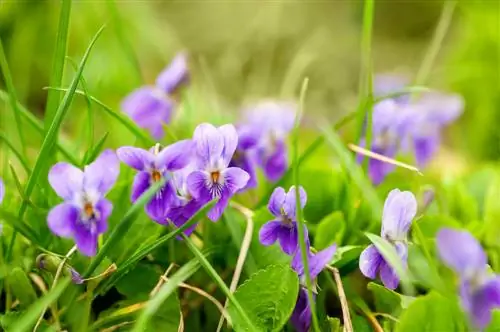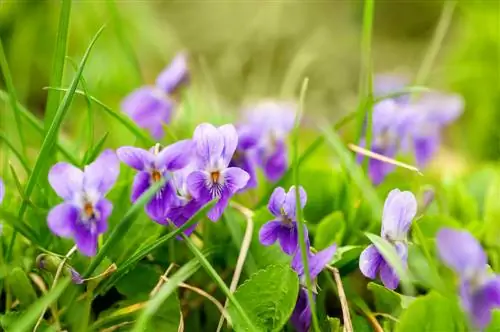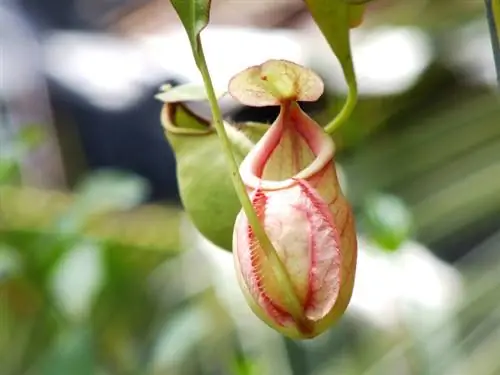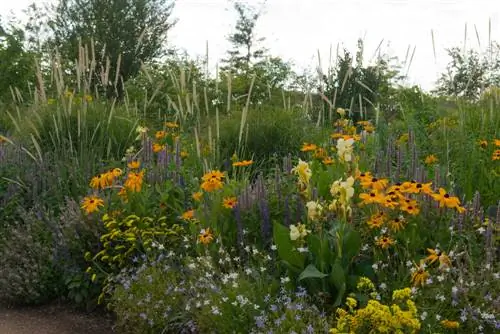- Author admin [email protected].
- Public 2023-12-16 16:46.
- Last modified 2025-01-23 11:21.
Scented violets captivate the senses with their aesthetic flowers that emit a sweet scent. They are typical plants in partially shaded forest locations. Their requirements make the scented violet the perfect plant for various themed gardens. In the right location, the violets require little care.

What properties do scented violets have?
Scented violets (Viola odorata) are perennial, wintergreen plants that grow to a height of between 5 and 15 cm and develop intensely fragrant, purple flowers from March to April. They are particularly suitable for partially shaded locations in gardens, as underplanting for trees or in theme gardens.
Origin
Scented violets are known to botanists as Viola odorata. The species suffix “odorata” indicates the intensely fragrant flowers. This property gave the plant its German name. It is also known as sweet violet or March violet.
The viola, which is a member of the violet family, is distributed between the Mediterranean and the Caucasus. It occurs in large parts of Europe, where it grows on forest edges and shady paths and forms the undergrowth of bushes. The fragrant violet has been cultivated in gardens since ancient times. The species has been used as an ornamental and useful plant in Central Europe since the Middle Ages.
Growth
The herbaceous plant is perennial and forms underground rhizomes as an overwintering organ. The above-ground shoot develops runners close to the surface of the earth, with which the plant gradually spreads throughout its location. In this way, scented violets develop dense lawns that cover the ground within a short period of time. The prerequisite is undisturbed growth. Fragrant violets reach heights of between five and 15 centimeters.
leaves
Scented violets develop basal leaf rosettes with several leaves. They are divided into a long petiole and a heart- to kidney-shaped blade. It appears grass green and has a simple structure. Due to the similar dimensions in width and length, the leaves appear rounded. The stem is covered with backward-facing hairs. Fragrant violets have two tiny bracts about halfway down the stem. The foliage is wintergreen and provides colorful accents during the cold season.
Bloom
Nodding single flowers appear from March to April, rising above the leaf rosettes with their long flower stalks. They exude a fragrant scent and, as spring bloomers, are an important source of food for butterflies and bumblebees. The flowers consist of five petals that are unevenly shaped and dark purple in color. There are varieties that bloom pink or white. The crown reaches a size of between two and three centimeters.
Fruit
After flowering, fragrant violets develop three-lobed capsule fruits. Their walls are elastic and open at seed maturity to release the spherical seeds. They are spread by ants, so the scented violet spreads quickly throughout the garden.
Usage
Due to its tolerance of low-light locations, Viola odorata is ideal for planting under wild hedges, woody plants or shrubs such as peonies and roses. They also grow without problems under root competition from neighboring trees. The low plants prove to be sturdy and can be planted directly in the lawn or in a walk-in flower meadow. They create an aesthetic long-distance effect and are particularly effective in closely packed groups.
Planting partner
You can combine fragrant violets with other early bloomers and create a colorful spring backdrop. Winter aconites, crocuses and daffodils are suitable combination partners. Viola odorata harmonizes with other flowering plants that have similar site conditions. The violet-flowering common night violet or the red foxglove also prefer partially shaded places under trees.
Scented violets are suitable for various themed gardens:
- Apothecary garden with medicinal herbs
- Farm garden with tall wild perennials
- wild natural gardens
- shady to semi-shady forest gardens
- Pot arrangements on roof gardens
Edible
Scented violets develop aromatic flowers that are used for various dishes. They refine salads or soups and give flower butter a sweet note. The flowers can be used for tea, syrup or liqueur or in candied form as a decoration for ice cream, desserts and cakes.
Which location is suitable?
The natural habitats of Viola odorata ensure partially shaded to light conditions with good ventilation. The delicate plants can only tolerate heat and direct sunlight if there is sufficient moisture in the soil. The fragrant violet feels at home under summer-green hedges and bushes.
What soil does the plant need?
The substrate should be nutrient-rich and provide fresh conditions. High permeability prevents the formation of waterlogging. A moderately acidic loamy soil with humus content is ideal. A mixture of potting soil (€10.00 on Amazon) and clay powder that is watered sufficiently provides the plant with perfect conditions. Viola odorata grows in humus-rich garden soil and proves to be unproblematic if the soil is sandy.
Propagate scented violets
Viola odorata is known for self-sowing via seeds and runners. If you want to propagate the plant specifically, you can divide large stocks or collect and sow seeds.
Division
Dig up the plants in spring and divide the rhizome in half with a sharp knife. Each daughter plant should have enough leaves so that it grows quickly. Mix some compost into the substrate at the new location to ensure optimal growing conditions for the divided plants.
When division makes sense:
- Inventory rejuvenation
- Change location
- Propagation
Sowing
Scented violets are cold germs. Sow the seeds in the bed between September and November. Alternatively, you can wrap the seeds in a damp cloth or sprinkle them in a freezer bag filled with sand and store them in the refrigerator for several weeks. Then sprinkle the seeds on a moist growing substrate and place the container in a bright place.
Scented violets germinate at a temperature of 18 degrees Celsius. As soon as the seedlings have developed a few leaves, they are separated. The plants can be placed directly in the bed.
Scented violets in a pot
Viola odorata is suitable as a houseplant. It can be planted individually in a pot or placed in a larger pot with other wild herbs. Make sure you have an optimal water supply. Fragrant violets require a constantly moist substrate. Drain any accumulated water from the saucer to prevent the roots from getting wet. The pot should be placed in a bright location without direct sunlight.
Water scented violets
The wintergreen plants have a medium water requirement. Young plants initially need uniform moisture conditions in the substrate. Once established, scented violets do not require additional watering in partially shaded locations under trees. If you have planted the plants on a lawn in a sunny location, you will have to use the watering can regularly. This also applies during long dry periods.
Fertilize fragrant violets properly
Regular fertilization is not necessary in nutrient-rich soils. Mix some compost into the substrate in spring so that the plants are optimally supplied during their growth and flowering phase. Pond mud or pond water achieve the same effect.
Cut fragrant violets correctly
The violet plants do not require pruning. Dried leaves can be removed if they disturb the overall appearance. If you leave wilted foliage on the plant, it will be broken down by soil organisms until the next growing season. This releases nutrients so that they can be absorbed and used by the plant. In this way, rotting leaves serve as natural fertilizer.
Wintering
Viola odorata is completely hardy. Their wintergreen leaves survive the frosty season without protection. If the plants grow under tall trees, they are optimally protected from the winter sun on snow-free days.
Container plants must be kept frost-free over the winter because the substrate freezes quickly. Place the container in a bright and cool place. An unheated winter garden or a bright place in the basement or hallway is ideal. Make sure that the substrate remains evenly moist. The plants are not fertilized.
Pests
Both outdoor plants and potted violets are occasionally attacked by pests. While potted plants often suffer from infestation during overwintering, unwanted guests appear on bedding plants in spring.
Spider mites
These pests prefer to attack potted plants in winter quarters when the air is too dry and warm. Spray the plant regularly with water and ensure an evenly moist substrate. This measure also has an effect on infected plants.
Gall or violet midges
Gall midges affect the development of flowers. The insects lay their eggs in the buds so that the hatched larvae can feed on the fresh flowers. Remove affected buds that appear swollen and have an uneven shape.
Snails
Freshly emerging leaves are a popular source of food for snails in spring. Young plants should therefore be grown in isolation. You can build a snail fence to protect outdoor plants. Sharp-edged stones provide a natural-looking obstacle.
Fungal infestation
Potted plants that are in poorly ventilated locations are colonized by downy mildew if the humidity is too high. The infestation can be recognized by a gray flour coating. Clean affected leaves and spray the plant weekly with a solution of one part milk to eight parts water.
Scented violet does not bloom
Various reasons can arise if fragrant violets do not bloom. Check the site conditions and ensure consistently high humidity. Soil that is too calcareous can prevent the plants from developing flowers. Add an acidic component to the soil. For container plants, use a container that is one to two centimeters larger than the root ball. They need winter rest to flower.
Flowers and location:
- lush flowers and small leaves in nutrient-poor forest locations
- large leaves and lack of flowers near fertilized beds
Tip
Scented violets grow easily under birch trees where other plants have difficulty surviving. Plant different varieties to create a colorful arrangement. The plants develop hybrids with new colors.
Varieties
- Suphurea: Weak growth, not wintergreen. Recommended for container planting. Yellow flowering.
- Lydia Groves: Flowers are pale pink with an orange-yellow center, sweetly scented. Up to 15 centimeters high.
- Alba: Pure white flowers. Reaches heights of up to 15 centimeters.






